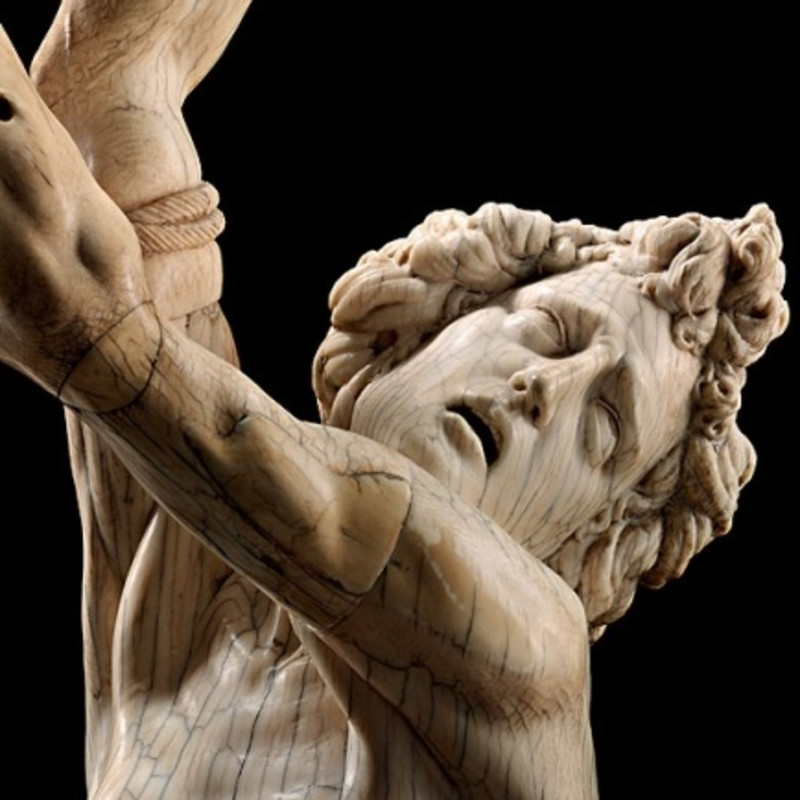Once again, Andrew Butterfield and Fabrizio Moretti, the renowned Renaissance and Baroque specialists, will collaborate to present Agony, Ecstasy, Ivory: The Saint Sebastian of Agnesius, A Rediscovered Masterpiece, at Moretti Fine Art/Adam Williams Fine Art, 24 East 80th Street, January 21–February 4, 2011.
Saint Sebastian of Agensius Master of the Osservanza, Flight into Egypt Coinciding with the Old Master Drawings Week and the auction house sales, this rare sculpture accompanies an exhibition of significant Italian and other European Old Master paintings, including works by Bicci de Lorenzo, Francesco Ubertini called ‘il Bacchiacca’, Master of the Osservanza, Giovanni Antonio Canal, called Canaletto, and Luis Melendez.
The Saint Sebastian by Jacobus Agnesius, circa 1638, - one of the largest and most spectacular ivory statues ever created—will be on public view for the first time.
“In my opinion, this beautiful ivory statue is an absolute masterpiece,” said Andrew Butterfield. “It is one of the largest and most astonishingly detailed sculptures in its representation of the anatomy and has a degree of raw emotional power found only in very great works of art.”
The statue is two feet tall, twice the size of what is normally considered large for a work in ivory. Given its scale and its quality, it was almost certainly commissioned for a prince or other royal patron.
Not only is it significantly larger than almost any other ivory statuette to survive, it was made in emulation of the grandeur and the seriousness of monumental sculpture in marble. Jacobus Agnesius aspired to carve this ivory in the spirit of Bernini’s Apollo and Daphne, or the celebrated classical statue of the Laocöon, widely recognized as an ideal image of heroic suffering. The result is a work of extraordinary beauty and power.
“With its luscious yet exacting portrayal of the human body, its grim depiction of emotional and physical suffering, and its suggestion of the exaltation of religious release, Agnesius’s Saint Sebastian is almost without parallel,” said Butterfield.
Little is known about the life of Jacobus Agnesius, who was most likely from northern Europe, but studied and worked extensively in Italy. Works by his hand are exceedingly rare, and up to now only two have been universally recognized: the Martyrdom of Saint Bartholomew in the Musée Toulouse-Lautrec in Albi, France, signed by the artist and dated 1638; and the Saint Sebastian in the Musée du Louvre, Paris. Each of these works is a masterpiece, noteworthy both for the unsurpassed skill of the carving, as well as the dramatic representation of intense suffering.
“We are very pleased to present a selection of paintings by Renaissance Old Masters,” said Fabrizio Moretti. “Of particular note are Caneletto’s A Capriccio of the Prisons of San Marco set in a Piazza With A Coach and Figures Conversing, and Flight into Egypt, by Master of the Osservanza.“
“Of all the paintings by Caneletto, this one has the most distinguished provenance a painting by him can have,” said Moretti. Painted for the artist's great patron and agent Joseph Smith, who was largely responsible for the painter's career, from the early 1720s onwards, it subsequently was passed along with much of his collection to King George III in 1762.
It originally formed part of a series of thirteen canvases of similar size presumably intended as over-doors to decorate the Palazzo Mangilli-Valmarana, Smith's house on the Grand Canal just above the Rialto Bridge. Five of these are signed and dated 1744 (in June of which year Smith was appointed British Consul) and it must be presumed that all were executed at, or around, that date.
The Master of the Osservanza has been described as one of the outstanding Sienese artists of the second quarter of the fifteenth century. In Flight into Egypt, the Virgin holds the Christ child closely, presenting Him to the viewer as she rides the mule. Saint Joseph appears at the left side of the composition holding two sticks to keep the mule at a gallop. Both he and the Virgin look in the distance as they walk through the landscape that frames them. This small panel is the companion to The Dream of Saint Joseph, a tripartite altarpiece portraying the Birth of the Virgin.
